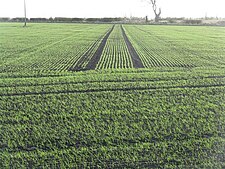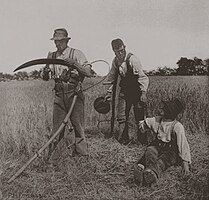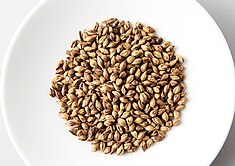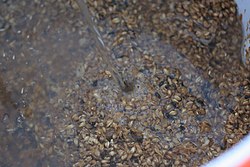Barley
| Barley | |
|---|---|

|
|
| Scientific classification | |
| Kingdom: | Plantae |
| Clade: | Tracheophytes |
| Clade: | Angiosperms |
| Clade: | Monocots |
| Clade: | Commelinids |
| Order: | Poales |
| Family: | Poaceae |
| Subfamily: | Pooideae |
| Genus: | Hordeum |
| Species: |
H. vulgare
|
| Binomial name | |
|
Hordeum vulgare |
|
| Synonyms | |
|
See § Synonyms. |
|
Barley (Hordeum vulgare), a member of the grass family, is a major cereal grain grown in temperate climates globally. It was one of the first cultivated grains; it was domesticated in Eurasia some 9,000 years ago. Globally 70% of barley production is used as animal fodder, while 30% as a source of fermentable material for beer, or further distilled into whisky, and as a component of various foods. It is used in soups and stews, and in barley bread of various cultures. Barley grains are commonly made into malt in a traditional and ancient method of preparation.
In 2022, barley was fourth among grains in quantity produced (155 million tonnes or 340 billion pounds) behind maize (corn), wheat, and rice.
Etymology
The Old English word for barley was bere; it survives in the north of Scotland as bere; it is used for a strain of six-row barley grown there. Modern English barley derives from the Old English adjective bærlic, meaning "of barley". The word barn derives from Old English bere-aern meaning "barley-store".
The name of the genus is from Latin hordeum, barley, likely related to Latin horrere, to bristle.
Description
Barley is a cereal, a member of the grass family with edible grains. Its flowers are clusters of spikelets arranged in a distinctive herringbone pattern. Each spikelet has a long thin awn (to 160 mm (6.3 in) long), making the ears look tufted. The spikelets are in clusters of three. In six-row barley, all three spikelets in each cluster are fertile; in two-row barley, only the central one is fertile. It is a self-pollinating, diploid species with 14 chromosomes.
-
 Botanical illustration of leafy stem with roots, flowers, and 2- and 6-row ears
Botanical illustration of leafy stem with roots, flowers, and 2- and 6-row ears -
 One cluster of 6-row barley showing the three fertile spikelets
One cluster of 6-row barley showing the three fertile spikelets
History
Domestication

Barley was one of the first grains to be domesticated in the Fertile Crescent, an area of relatively abundant water in Western Asia, around 11,000 years ago (circa 9,000 BCE). Wild barley (H. vulgare ssp. spontaneum) ranges from North Africa and Crete in the west to Tibet in the east. However, in a study of genome-wide diversity markers, Tibet was found to be an additional center of domestication of cultivated barley. The earliest archaeological evidence of the consumption of wild barley, Hordeum spontaneum, comes from the Epipaleolithic at Ohalo II at the southern end of the Sea of Galilee, where grinding stones with traces of starch were found. The remains were dated to about 23,000 BCE. The earliest evidence for the domestication of barley, in the form of cultivars that cannot reproduce without human assistance, comes from Mesopotamia, specifically the Jarmo region of modern-day Iraq, around 9,000-7,000 BCE.
Domestication changed the morphology of the barley grain substantially, from an elongated shape to a more rounded spherical one. Wild barley has distinctive genes, alleles, and regulators with potential for resistance to abiotic or biotic stresses; these may help cultivated barley to adapt to climatic changes. Wild barley has a brittle spike; upon maturity, the spikelets separate, facilitating seed dispersal. Domesticated barley has nonshattering spikes, making it much easier to harvest the mature ears. The nonshattering condition is caused by a mutation in one of two tightly linked genes known as Bt1 and Bt2; many cultivars possess both mutations. The nonshattering condition is recessive, so varieties of barley that exhibit this condition are homozygous for the mutant allele. Domestication in barley is followed by the change of key phenotypic traits at the genetic level.
Spread
Barley is a highly resilient crop, able to be grown in varied and marginal environments, such as in regions of high altitude and latitude. Archaeobotanical evidence shows that barley had spread throughout Eurasia by 2,000 BCE. To further elucidate the routes by which barley cultivation was spread through Eurasia, genetic analysis was used to determine genetic diversity and population structure in extant barley taxa. Genetic analysis shows that cultivated barley spread through Eurasia via several different routes over time.

By 4200 BCE domesticated barley occurs as far as Eastern Finland. Barley has been grown in the Korean Peninsula since the Early Mumun Pottery Period (circa 1500–850 BCE). Barley (Yava in Sanskrit) is mentioned many times in the Rigveda and other Indian scriptures as a principal grain in ancient India. Traces of Barley cultivation have been found in post-Neolithic Bronze Age Harappan civilization 5,700–3,300 years ago.
In his book Guns, Germs, and Steel, Jared Diamond proposed that the availability of barley in southwestern Eurasia contributed to the broad historical patterns that human history has followed over the last 13,000 years. Diamond's proposition has been criticized for downplaying individual and cultural choice and autonomy.
Barley beer was probably one of the first alcoholic drinks developed by Neolithic humans. Barley later on was used as currency. The Sumerian language had a word for barley, akiti. In ancient Mesopotamia, a stalk of barley was the primary symbol of the goddess Shala.
| jt barley determinative/ideogram |
|
||||
| jt (common) spelling |
|
||||
| šma determinative/ideogram |
|
Rations of barley for workers appear in Linear B tablets in Mycenaean contexts at Knossos and at Mycenaean Pylos. In mainland Greece, the ritual significance of barley possibly dates back to the earliest stages of the Eleusinian Mysteries. The preparatory kykeon or mixed drink of the initiates, prepared from barley and herbs, referred in the Homeric hymn to Demeter, whose name some scholars believe meant "Barley-mother". The practice was to dry the barley groats and roast them before preparing the porridge, according to Pliny the Elder's Natural History.
Tibetan barley has been a staple food in Tibetan cuisine since the fifth century CE. This grain, along with a cool climate that permitted storage, produced a civilization that was able to raise great armies. It is made into a flour product called tsampa that is still a staple in Tibet.
In medieval Europe, bread made from barley and rye was peasant food, while wheat products were consumed by the upper classes. Potatoes largely replaced barley in Eastern Europe in the 19th century.
Taxonomy and varieties
Two-row and six-row barley

Spikelets are arranged in triplets which alternate along the rachis. In wild barley (and other Old World species of Hordeum), only the central spikelet is fertile, while the other two are reduced. This condition is retained in certain cultivars known as two-row barleys. A pair of mutations (one dominant, the other recessive) result in fertile lateral spikelets to produce six-row barleys. Recent genetic studies have revealed that a mutation in one gene, vrs1, is responsible for the transition from two-row to six-row barley.
Two-row barley, sometimes considered a separate species, H. distichon, has a lower protein content than six-row barley, thus a more fermentable sugar content. High-protein barley is best suited for animal feed. Malting barley is usually lower protein ("low grain nitrogen", usually produced without a late fertilizer application) which shows more uniform germination, needs shorter steeping, and has less protein in the extract that can make beer cloudy. Two-row barley is traditionally used in English ale-style beers, with two-row malted summer barley being preferred for traditional German beers. Barley often assessed by its malting enzyme content.
Hulless barley
Hulless or "naked" barley (Hordeum vulgare L. var. nudum Hook. f.) is a form of domesticated barley with an easier-to-remove hull. Naked barley is an ancient food crop, but a new industry has developed around uses of selected hulless barley to increase the digestibility the grain, especially for pigs and poultry. Hulless barley has been investigated for several potential new applications as whole grain and for its value-added products. These include bran and flour for multiple food applications.
Classification issues
In traditional classifications of barley, morphological differences have led to different forms of barley being classified as different species. Under these classifications, two-row barley with shattering spikes (wild barley) is classified as Hordeum spontaneum (K. Koch). Two-row barley with nonshattering spikes is classified as H. distichon (L.), six-row barley with nonshattering spikes as H. vulgare L. (or H. hexastichum L.), and six-row with shattering spikes as H. agriocrithon Åberg. Because these differences were driven by single-gene mutations, coupled with cytological and molecular evidence, most recent classifications treat these forms as a single species, H. vulgare L.
Taxonomists have created many taxa now regarded as synonyms for barley over the years.
-
- Frumentum hordeum E.H.L.Krause nom. illeg.
- Frumentum sativum E.H.L.Krause
- Hordeum aestivum R.E.Regel nom. inval.
- Hordeum americanum R.E.Regel nom. inval.
- Hordeum bifarium Roth
- Hordeum brachyatherum R.E.Regel nom. inval.
- Hordeum caspicum R.E.Regel nom. inval.
- Hordeum coeleste (L.) P.Beauv.
- Hordeum daghestanicum R.E.Regel nom. inval.
- Hordeum defectoides R.E.Regel nom. inval.
- Hordeum durum R.E.Regel nom. inval.
- Hordeum elongatum R.E.Regel nom. inval.
- Hordeum gymnodistichum Duthie
- Hordeum heterostychon P.Beauv. [Spelling variant]
- Hordeum hexastichon L.
- Hordeum hibernaculum R.E.Regel nom. inval.
- Hordeum hibernans R.E.Regel nom. inval.
- Hordeum himalayense Schult.
- Hordeum hirtiusculum R.E.Regel nom. inval.
- Hordeum horsfordianum R.E.Regel nom. inval.
- Hordeum ircutianum R.E.Regel nom. inval.
- Hordeum jarenskianum R.E.Regel nom. inval.
- Hordeum juliae R.E.Regel nom. inval.
- Hordeum kalugense R.E.Regel nom. inval.
- Hordeum karzinianum R.E.Regel nom. inval.
- Hordeum kiarchanum R.E.Regel nom. inval.
- Hordeum laevipaleatum R.E.Regel nom. inval.
- Hordeum lapponicum R.E.Regel nom. inval.
- Hordeum leptostachys Griff.
- Hordeum macrolepis A.Braun
- Hordeum mandshuricum R.E.Regel nom. inval.
- Hordeum mandshuroides R.E.Regel nom. inval.
- Hordeum michalkowii R.E.Regel nom. inval.
- Hordeum nekludowii R.E.Regel nom. inval.
- Hordeum nigrum Willd.
- Hordeum pamiricum Vavilov nom. inval.
- Hordeum parvum R.E.Regel nom. inval.
- Hordeum pensanum R.E.Regel nom. inval.
- Hordeum polystichon Haller
- Hordeum praecox R.E.Regel nom. inval.
- Hordeum pyramidatum R.E.Regel nom. inval.
- Hordeum revelatum (Körn.) A.Schulz
- Hordeum sativum Jess. nom. illeg.
- Hordeum sativum Pers. nom. inval.
- Hordeum scabriusculum R.E.Regel nom. inval.
- Hordeum septentrionale R.E.Regel nom. inval.
- Hordeum stassewitschii R.E.Regel nom. inval.
- Hordeum strobelense Chiov.
- Hordeum taganrocense R.E.Regel nom. inval.
- Hordeum tanaiticum R.E.Regel nom. inval.
- Hordeum tetrastichum Stokes
- Hordeum transcaucasicum R.E.Regel nom. inval.
- Hordeum violaceum R.E.Regel nom. inval.
- Hordeum walpersii R.E.Regel nom. inval.
- Secale orientale Schreb. ex Roth nom. inval.
Genetics
The genome of barley was sequenced in 2012 due to the efforts of the International Barley Genome Sequencing Consortium and the UK Barley Sequencing Consortium. The genome is composed of seven pairs of nuclear chromosomes (recommended designations: 1H, 2H, 3H, 4H, 5H, 6H and 7H), and one mitochondrial and one chloroplast chromosome, with a total of 5000 Mbp. Details of the genome are freely available in several barley databases.
The wild barley (H. vulgare ssp. spontaneum) found currently in the Fertile Crescent might not be the progenitor of the barley cultivated in Eritrea and Ethiopia, indicating that separate domestication may have occurred in eastern Africa.
For durable disease resistance, quantitative resistance is more important than qualitative resistance. The most important foliar diseases have corresponding resistance gene regions on all chromosomes of barley. A large number of molecular markers are available for breeding of resistance to leaf rust, powdery mildew, Rhynchosporium secalis, Pyrenophora teres f. teres, Barley yellow dwarf virus, and the Barley yellow mosaic virus complex.
Barley has been crossed with wheat with mixed results that have yet to prove commercially viable. The resulting hybrids have further been crossed with rye, but with even more limited results.
| Barley production – 2022 | |
|---|---|
| Country | Millions of tonnes |
| Russia | 23.4 |
| France | 11.3 |
| Germany | 11.2 |
| Canada | 10.0 |
| Turkey | 8.5 |
| Spain | 7.0 |
| World | 154.9 |
Production
In 2022, world production of barley was 155 million tonnes, led by Russia accounting for 15% of the world total (table). France, Germany, and Canada were secondary producers. Worldwide barley production was fourth among grains, following maize (1.2 billion tonnes), wheat (808 million tonnes), and rice (776 million tonnes).
Cultivation
Barley is a widely adaptable crop. It is grown in temperate areas as a summer crop, and in tropical areas where it is sown as a winter crop. Its germination time is one to three days. Barley grows under cool conditions, but is not particularly winter hardy.
Barley is more tolerant of soil salinity than wheat, which might explain the increase of barley cultivation in Mesopotamia from the second millennium BCE onwards. Barley is not as cold tolerant as the winter wheats (Triticum aestivum), fall rye (Secale cereale) or winter triticale (× Triticosecale Wittm. ex A. Camus.), but it may be sown as a winter crop in warmer areas of Australia and Great Britain.
Barley has a short growing season and is relatively drought tolerant.
-
 Young winter barley in early November,
Young winter barley in early November,
Scotland, 2009 -
 Spraying barley for rust fungus,
Spraying barley for rust fungus,
New Zealand, 1979 -

-
 Harvesting winter barley with a combine harvester, Germany, 2017
Harvesting winter barley with a combine harvester, Germany, 2017
Plant diseases
Serious fungal diseases of barley include powdery mildew caused by Blumeria graminis, leaf scald caused by Rhynchosporium secalis, barley rust caused by Puccinia hordei, crown rust caused by Puccinia coronata, various diseases caused by Cochliobolus sativus, Fusarium ear blight, and Stem rust (Puccinia graminis).
Bacterial diseases of barley include bacterial blight caused by Xanthomonas campestris pv. translucens.
Barley is susceptible to several viral diseases, such as barley mild mosaic bymovirus. Barley yellow dwarf virus, vectored by the rice root aphid, causes serious crop injury.
Food
 | |
| Nutritional value per 100 g (3.5 oz) | |
|---|---|
| Energy | 515 kJ (123 kcal) |
28.2 g |
|
| Sugars | 0.3 g |
| Dietary fiber | 3.8 g |
0.4 g |
|
2.3 g |
|
| Vitamins |
Quantity
%DV†
|
| Vitamin A equiv. |
0% 0 μg0% 5 μg56 μg
|
| Thiamine (B1) |
7% 0.083 mg |
| Riboflavin (B2) |
5% 0.062 mg |
| Niacin (B3) |
14% 2.063 mg |
| Pantothenic acid (B5) |
3% 0.135 mg |
| Vitamin B6 |
9% 0.115 mg |
| Folate (B9) |
4% 16 μg |
| Vitamin B12 |
0% 0 μg |
| Choline |
3% 13.4 mg |
| Vitamin C |
0% 0 mg |
| Vitamin D |
0% 0 IU |
| Vitamin E |
0% 0.01 mg |
| Vitamin K |
1% 0.8 μg |
| Minerals |
Quantity
%DV†
|
| Calcium |
1% 11 mg |
| Copper |
5% 0.105 mg |
| Iron |
10% 1.3 mg |
| Magnesium |
6% 22 mg |
| Manganese |
12% 0.259 mg |
| Phosphorus |
8% 54 mg |
| Potassium |
2% 93 mg |
| Sodium |
0% 3 mg |
| Zinc |
9% 0.82 mg |
| Other constituents | Quantity |
| Water | 68.8 g |
| Cholesterol | 0 mg |
|
| |
| |
| †Percentages are roughly approximated using US recommendations for adults. | |
Preparation

Hulled barley (or covered barley) is eaten after removing the inedible, fibrous, outer husk or hull. Once removed, it is called dehulled barley (or pot barley or scotch barley). Pearl barley (or pearled barley) is dehulled to remove most of the bran, and polished. Barley meal, a wholemeal barley flour lighter than wheat meal but darker in colour, is used in gruel. This gruel is known as سويق : sawīq in the Arab world.
With a long history of cultivation in the Middle East, barley is used in a wide range of traditional Arabic, Assyrian, Israelite, Kurdish, and Persian foodstuffs including kashkak, kashk and murri. Barley soup is traditionally eaten during Ramadan in Saudi Arabia. Cholent or hamin (in Hebrew) is a traditional Jewish stew often eaten on Sabbath, in numerous recipes by both Mizrachi and Ashkenazi Jews; its original form was a barley porridge.

In Eastern and Central Europe, barley is used in soups and stews such as ričet. In Africa, where it is a traditional food plant, it has the potential to improve nutrition, boost food security, foster rural development, and support sustainable landcare.
The six-row variety bere is cultivated in Orkney, Shetland, Caithness and the Western Isles in the Scottish Highlands and islands. When milled into beremeal, it is used locally in bread, biscuits, and the traditional beremeal bannock.
In Japanese and Korean cuisines, barley is steamed like steamed rice. In Japan, it is mixed with rice. Barley rice, called mugimeshi in Japanese, and bori-bap (보리밥) in Korean, was for a long time a peasant staple intended to conserve the expensive rice. The naval surgeon Takaki Kanehiro introduced it into the institutional cooking to combat beriberi, endemic in the armed forces of the time. It remains a staple in the Japan Self-Defense Forces, but it received far more publicity as a stereotypical prison fare, to the point that "eating mugimeshi" can be heard as a euphemism of "doing time".
Nutrition
Cooked barley is 69% water, 28% carbohydrates, 2% protein, and 0.4% fat (table). In a 100-gram (3.5 oz) reference serving, cooked barley provides 515 kilojoules (123 kcal) of food energy and is a good source (10% or more of the Daily Value, DV) of essential nutrients, including, dietary fibre, the B vitamin, niacin (14% DV), and dietary minerals, including iron (10% DV) and manganese (12% DV) (table).
Health implications
According to Health Canada and the US Food and Drug Administration, consuming at least 3 grams per day of barley beta-glucan can lower levels of blood cholesterol, a risk factor for cardiovascular diseases. Eating whole-grain barley, a high-fibre grain, improves regulation of blood sugar (i.e., reduces blood glucose response to a meal). Consuming breakfast cereals containing barley over weeks to months improves cholesterol levels and glucose regulation. Barley contains gluten, which makes it an unsuitable grain for consumption by people with gluten-related disorders, such as celiac disease, non-celiac gluten sensitivity and wheat allergy sufferers, among others. Nevertheless, some wheat allergy patients can tolerate barley.
Uses
Beer, whisky, and soft drinks
Barley is a key ingredient in beer and whisky production. Two-row barley is traditionally used in German and English beers. Six-row barley was traditionally used in US beers, but both varieties are in common usage now. Distilled from green beer, Scottish and Irish whisky are made primarily from barley. About 25% of American barley is used for malting, for which barley is the best-suited grain. Barley wine is a style of strong beer from the English brewing tradition. An 18th century alcoholic drink of the same name was made by boiling barley in water, then mixing the barley water with white wine, borage, lemon and sugar. In the 19th century, a different barley wine was prepared from recipes of ancient Greek origin.
Nonalcoholic drinks such as barley water and roasted barley tea have been made by boiling barley in water. In Italy, barley is sometimes used as coffee substitute, caffè d'orzo (barley coffee).
-

-
 Barley grains being mashed (heated with water) for brewing beer
Barley grains being mashed (heated with water) for brewing beer -
 Barley wines are strong ales.
Barley wines are strong ales. -
 Boricha, Korean roasted barley tea
Boricha, Korean roasted barley tea
Animal feed

Half of the United States' barley production is used as livestock feed. Barley is an important feed grain in many areas of the world not typically suited for maize production, especially in northern climates—for example, northern and eastern Europe. Barley is the principal feed grain in Canada, Europe, and in the northern United States. A finishing diet of barley is one of the defining characteristics of western Canadian beef used in marketing campaigns.
In 2014, an enzymatic process was devised to make a high-protein fish feed from barley, suitable for carnivorous fish such as trout and salmon.
Other uses
Barley straw has been placed in mesh bags and floated in fish ponds or water gardens to help prevent algal growth without harming pond plants and animals. The technique's effectiveness is at best mixed.
Barley grains were once used for measurement in England, there being nominally three or four barleycorns to the inch. By the 19th century, this had been superseded by standard inch measures.
A stabilized variegated variety of H. vulgare, billed as H. vulgare variegate, has been introduced for cultivation as an ornamental and pot plant for pet cats to nibble.
Culture and folklore
In English folklore, the figure of John Barleycorn in the folksong of the same name is a personification of barley, and of the alcoholic beverages made from it: beer and whisky. In the song, John Barleycorn is represented as suffering attacks, death, and indignities that correspond to the various stages of barley cultivation, such as reaping and malting.
English pub names such as Barley Mow, John Barleycorn, Malt Shovel, and Mash Tun allude to barley's role in the production of beer.
-
 Porcelain figurine of John Barleycorn, complete with songsheet and little brown jug of beer
Porcelain figurine of John Barleycorn, complete with songsheet and little brown jug of beer -
![English pub names such as The Barley Mow (like this pub at Clifton Hampden) allude to the use of barley to make the beer available inside.[83]](//upload.wikimedia.org/wikipedia/commons/thumb/e/e7/The_Barley_Mow%2C_Clifton_Hampden_%28wide%29.jpg/275px-The_Barley_Mow%2C_Clifton_Hampden_%28wide%29.jpg) English pub names such as The Barley Mow (like this pub at Clifton Hampden) allude to the use of barley to make the beer available inside.
English pub names such as The Barley Mow (like this pub at Clifton Hampden) allude to the use of barley to make the beer available inside.











![English pub names such as The Barley Mow (like this pub at Clifton Hampden) allude to the use of barley to make the beer available inside.[83]](http://upload.wikimedia.org/wikipedia/commons/thumb/e/e7/The_Barley_Mow%2C_Clifton_Hampden_%28wide%29.jpg/275px-The_Barley_Mow%2C_Clifton_Hampden_%28wide%29.jpg)